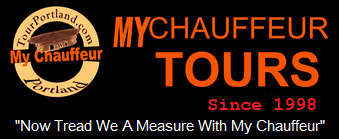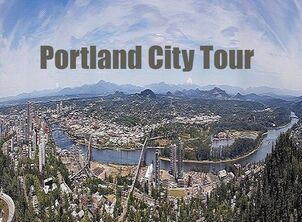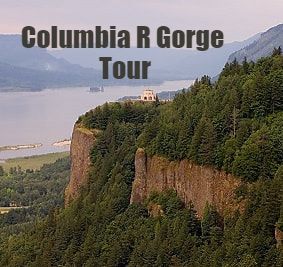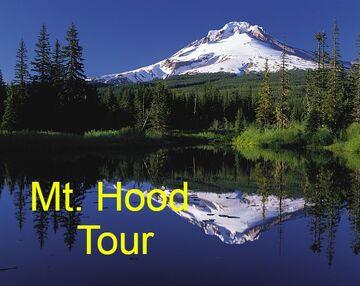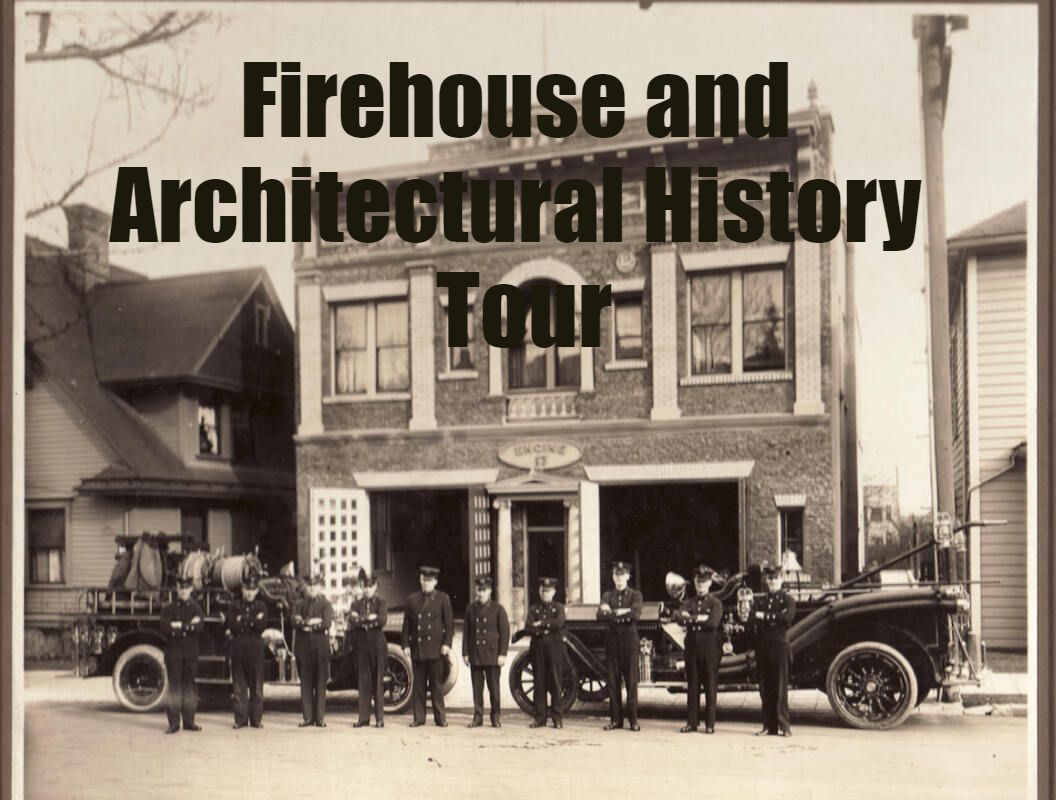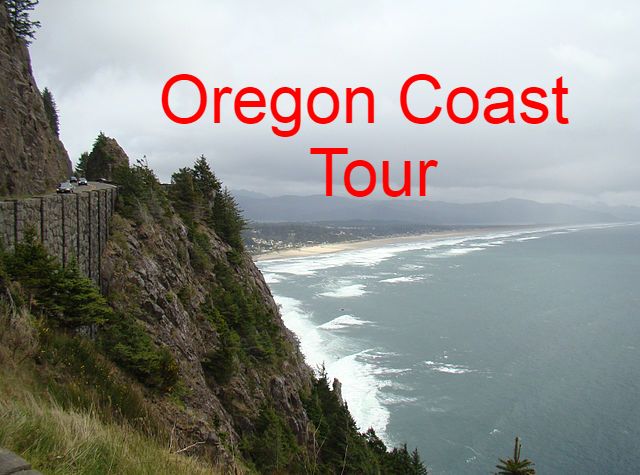The Park Blocks
We will be at "The South Park Blocks" in a few moments.
In 1852, the farsighted pioneers set aside 25 blocks of parkland running north to south through Portland intending the blocks to serve as both a promenade and possibly a firebreak, between real estate investments, and the wooded hills above the new town site.
By the 1870s, the South Park Blocks had become a prestigious residential district lined with Italianate mansions and churches.
Through the end of the nineteenth century, the Park Blocks developed as a "promenade ground", complete with Dutch elms planted in rows. And even, briefly, a racetrack.
Now known as the Cultural District, as the city moved westward, the "South Park Blocks" were chosen as the ideal place to locate some of the city's most important institutions like...
Our first sight.
The Oregon History Center & Sovereign Hotel, from 1966 & 1923, respectively. You will see, the far building, has 2 huge murals, one depicting the Lewis & Clark Expedition on the west side, and on the South side, the Pioneer Period.
In 1966, the Oregon Historical Society built its new Oregon History Center, and in later years, bought the historic Sovereign Hotel, to house the society's offices.
Permanent exhibits at the museum include:
Oregon's 1st car--The Benson, from 1904, an auto cobbled together in Nils Benson's garage, across the river on Grand Avenue.
The massive guestbook of the 1905 World's Fair.
The Portland Penny.
FOLLOW ALONG WITH PICTURES.
See Pictures, Portland Penny.
Let me know, if you want to view or learn more, about the Portland Penny.
And last we will mention, Oregon My Oregon, a 7,000-square-foot display covering Oregon’s history from early settlement to current times. Significant items include a reproduction of a ship's hull, a 1940s-era mercantile store, a complete lunch counter from a diner, and a 9,000-year-old sandal. The Fort Rock Sandals.
Highly recommended.
And, right after that, we will go by, the 1st Congregational Church, across from the Historical Society, and will be on our right.
It is from eighteen ninety five.
The lovely, Venetian Gothic, First Congregational Church, is a serene and stately presence on the South Park Blocks. Designed by the swiss Henry Hefty, at a cost of 110,000 dollars, over a 5 year Period. It resembles Boston’s New, Old South Church. It originally had 3 towers, in the 1940s. Only the main 185 foot one remains, in a modernization attempt. The main floor slopes downward, and seats 1100 people.
Next, among the sights along the Park Blocks, are, the Heroic statues of Theodore Roosevelt, and Abraham Lincoln.
The elegant, diminutive Rebecca at the Well fountain.
The Calumet (esquire) Hotel from 1907.
The Historic Cornelius Hotel from 1908.
The Masonic Temple, from 1924.
The Portland Art Museum, from 1930.
And right after the art museum, will be Saint James Lutheran Church, from 1891.
Let me know if you want to learn more about any of these institutions.
Next, we will briefly stop at, Lincoln High School (built in eighteen sixty nine).
It is one of the oldest high schools west of the Mississippi.
In 1952, Lincoln High, the City's 1st high school, was transformed into Lincoln Hall, the 1st building on the Park Blocks campus of Portland State University.
The American Renaissance Revival building was designed by the same designers of the Rockefeller Center (Whitehouse & Fouilhoux).
Our next stop on the park blocks after the high school, will be, the Simon Benson House.
Simon Benson was a wealthy Portland lumberman and was the principal benefactor of the Columbia River Historic Highway. He donated Multnomah Falls and Wahkeena Falls to Portland in 1915. The home is in the Queen Anne style with detailed ornamentation. Currently is part of the Portland State campus.
Let me know if you want to know more about Queen Anne architecture.
FOLLOW ALONG WITH PICTURES
See Picture, Simon Benson, right below the Portland Penny.
In the photograph Simon Benson poses in front of one of the twenty bronze drinking fountains he donated to the city. He hoped that the fountains, which cost $317 apiece, would encourage temperance.
Benson was an inventive lumberman, concerned with efficiency. At his lumber company, Benson replaced oxen, used to drag timber, with railroad engines made of salvaged parts thereby reducing both labor costs and saving time. When Benson decided to send his logs directly to San Diego, he designed log rafts, 835-feet in length, in order to avoid what he considered exorbitant freight rates. A wise decision—Benson’s company saved $150,000 dollars a year with this alteration in business standards.
Benson’s legacy lives on in Portland, with the once derelict, 120 year-old Benson family home (built in 1900), was renovated and moved in 2000 to the campus of Portland State University.
Outside the stately home, stands another Benson legacy: a Benson Bubbler fountain, installed all over downtown, and continues to splash fresh water for passers-by to enjoy.
This is your last chance, to sip from a Benson Bubbler.
Also here, is the home to the biggest Farmers Market in Portland, every Saturday from 8:30 to 2pm.
Our last stop along the park blocks, is THE OLD CHURCH, right after the Benson house.
Learn more about Portland Historical Architecture.
NEXT is the Old Church.
With many more.
Does anyone have any questions?
In 1852, the farsighted pioneers set aside 25 blocks of parkland running north to south through Portland intending the blocks to serve as both a promenade and possibly a firebreak, between real estate investments, and the wooded hills above the new town site.
By the 1870s, the South Park Blocks had become a prestigious residential district lined with Italianate mansions and churches.
Through the end of the nineteenth century, the Park Blocks developed as a "promenade ground", complete with Dutch elms planted in rows. And even, briefly, a racetrack.
Now known as the Cultural District, as the city moved westward, the "South Park Blocks" were chosen as the ideal place to locate some of the city's most important institutions like...
Our first sight.
The Oregon History Center & Sovereign Hotel, from 1966 & 1923, respectively. You will see, the far building, has 2 huge murals, one depicting the Lewis & Clark Expedition on the west side, and on the South side, the Pioneer Period.
In 1966, the Oregon Historical Society built its new Oregon History Center, and in later years, bought the historic Sovereign Hotel, to house the society's offices.
Permanent exhibits at the museum include:
Oregon's 1st car--The Benson, from 1904, an auto cobbled together in Nils Benson's garage, across the river on Grand Avenue.
The massive guestbook of the 1905 World's Fair.
The Portland Penny.
FOLLOW ALONG WITH PICTURES.
See Pictures, Portland Penny.
Let me know, if you want to view or learn more, about the Portland Penny.
And last we will mention, Oregon My Oregon, a 7,000-square-foot display covering Oregon’s history from early settlement to current times. Significant items include a reproduction of a ship's hull, a 1940s-era mercantile store, a complete lunch counter from a diner, and a 9,000-year-old sandal. The Fort Rock Sandals.
Highly recommended.
And, right after that, we will go by, the 1st Congregational Church, across from the Historical Society, and will be on our right.
It is from eighteen ninety five.
The lovely, Venetian Gothic, First Congregational Church, is a serene and stately presence on the South Park Blocks. Designed by the swiss Henry Hefty, at a cost of 110,000 dollars, over a 5 year Period. It resembles Boston’s New, Old South Church. It originally had 3 towers, in the 1940s. Only the main 185 foot one remains, in a modernization attempt. The main floor slopes downward, and seats 1100 people.
Next, among the sights along the Park Blocks, are, the Heroic statues of Theodore Roosevelt, and Abraham Lincoln.
The elegant, diminutive Rebecca at the Well fountain.
The Calumet (esquire) Hotel from 1907.
The Historic Cornelius Hotel from 1908.
The Masonic Temple, from 1924.
The Portland Art Museum, from 1930.
And right after the art museum, will be Saint James Lutheran Church, from 1891.
Let me know if you want to learn more about any of these institutions.
Next, we will briefly stop at, Lincoln High School (built in eighteen sixty nine).
It is one of the oldest high schools west of the Mississippi.
In 1952, Lincoln High, the City's 1st high school, was transformed into Lincoln Hall, the 1st building on the Park Blocks campus of Portland State University.
The American Renaissance Revival building was designed by the same designers of the Rockefeller Center (Whitehouse & Fouilhoux).
Our next stop on the park blocks after the high school, will be, the Simon Benson House.
Simon Benson was a wealthy Portland lumberman and was the principal benefactor of the Columbia River Historic Highway. He donated Multnomah Falls and Wahkeena Falls to Portland in 1915. The home is in the Queen Anne style with detailed ornamentation. Currently is part of the Portland State campus.
Let me know if you want to know more about Queen Anne architecture.
FOLLOW ALONG WITH PICTURES
See Picture, Simon Benson, right below the Portland Penny.
In the photograph Simon Benson poses in front of one of the twenty bronze drinking fountains he donated to the city. He hoped that the fountains, which cost $317 apiece, would encourage temperance.
Benson was an inventive lumberman, concerned with efficiency. At his lumber company, Benson replaced oxen, used to drag timber, with railroad engines made of salvaged parts thereby reducing both labor costs and saving time. When Benson decided to send his logs directly to San Diego, he designed log rafts, 835-feet in length, in order to avoid what he considered exorbitant freight rates. A wise decision—Benson’s company saved $150,000 dollars a year with this alteration in business standards.
Benson’s legacy lives on in Portland, with the once derelict, 120 year-old Benson family home (built in 1900), was renovated and moved in 2000 to the campus of Portland State University.
Outside the stately home, stands another Benson legacy: a Benson Bubbler fountain, installed all over downtown, and continues to splash fresh water for passers-by to enjoy.
This is your last chance, to sip from a Benson Bubbler.
Also here, is the home to the biggest Farmers Market in Portland, every Saturday from 8:30 to 2pm.
Our last stop along the park blocks, is THE OLD CHURCH, right after the Benson house.
Learn more about Portland Historical Architecture.
NEXT is the Old Church.
With many more.
Does anyone have any questions?
